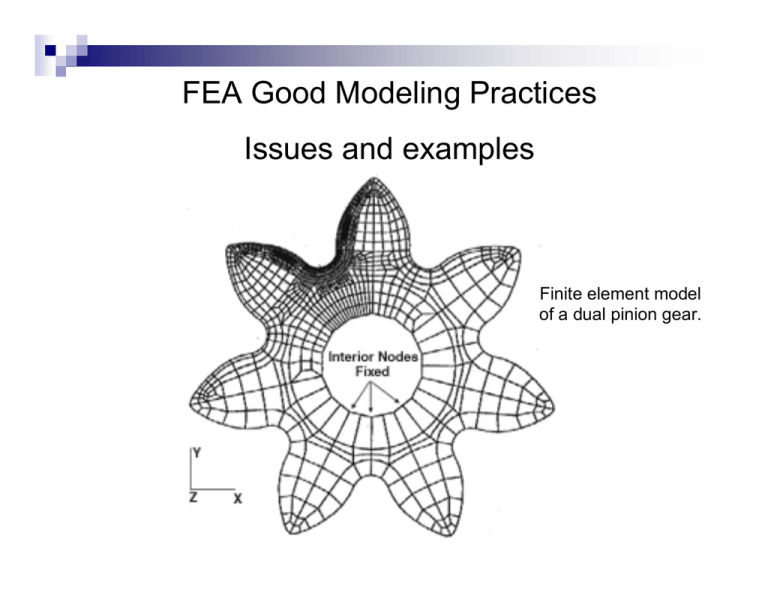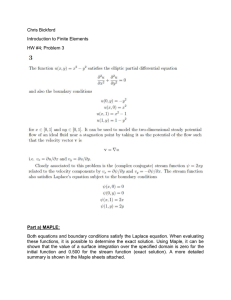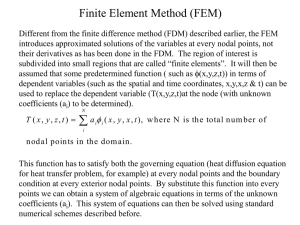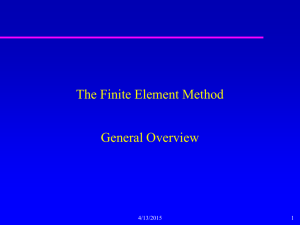FEA Good Modeling Practices Issues and examples
advertisement

FEA Good Modeling Practices
Issues and examples
Finite element model
of a dual pinion gear.
Finite Element Analysis (FEA)
Good modeling and analysis procedures
FEA is a powerful analysis tool, but use it with care.
Warnings
ALL MODELS ARE WRONG! - SOME ARE USEFUL.
An FEA program allows an engineer to make mistakes
at a rapid rate of speed. (R. Miller)
An error caused by misunderstanding or oversight is
not correctible by mesh refinement or by use of a
more powerful computer. (Cook)
Finite Element Analysis (FEA)
Good modeling and analysis procedures
FEA is a versatile tool, but not the best
analytical tool for every problem. (Cook)
An analysis is doomed to failure without
sufficient consideration of all available
tools to determine which is most
appropriate, and sufficient pre-analysis
planning to determine the required scope
and level of complexity for the analysis
and the required accuracy of the solution.
Basic Concepts in Finite Element Analysis
Divide and conquer - Simple linear equations
like F=Kx are not valid on a large scale for a
part with complex geometry but they can be
valid for a small region of material within the
complex part.
Therefore, if we break down a complex physical object into a
large but finite number of small pieces (elements) for
which simple equations can be solved with acceptable
accuracy (where numerical approximations are valid),
then build the structure back up (via nodal connectivity
and transferring solutions from one element to the next to
allow successive computation) we can create a
meaningful solution for the entire complex object.
σ = Eε or
F
A
Basic Concepts in Finite Element Analysis
Finite elements are small interconnected geometrical entities
connected to other elements through nodes (1D),
boundary lines (2D), and boundary surfaces (3D).
Elements contain the material information and determine how
the loads are transferred into displacements for all
connected nodes
FEM is actually displacement analysis {F}=[K]{x} with
node displacements determined by element
"stretching", followed by load and stress calculations
for the elements based on the nodal displacements
and the material properties
σ = Eε or
F
A
Basic Concepts in Finite Element Analysis
Nodes: basically coordinate locations,
they locate/define the endpoints of
all 1D elements and the corners of
all 2D & 3D elements.
Since all info goes into model and is computed for
the model on the nodal level (i.e. input nodal
forces and output nodal displacements), at a
minimum, nodes must be present at all locations
where there are changes in geometry or where
there are applied loads or boundary conditions.
Basic Concepts in Finite Element Analysis
•
•
Degrees of Freedom (DOF) & Associated Loads:
DOFs are the unknown quantities associated with a node,
or the things that must be solved for mathematically.
Associated loads are loads of the same direction and type
as the DOFs.
• For structural FEA the DOFs are displacements (or
rotations) and the associated loads are forces (or
moments).
Boundary Condition (BC): A boundary condition for the
model is the setting of a known value for a
displacement or an associated load. For a particular
node you can set either the load or the displacement
but not both.
Text: Building Better Products with FEA,
by V. Adams & A. Askenazi,
Boundary Conditions: the loads and constraints that represent the effect of the
surrounding environment on the model. (Everything else, that you have not modeled).
UNWANTED EFFECTS (p. 264-270)
Overconstrained, redundant supports, excessive constraint tend to add stiffness to the
model (stiffer than the real system)
Also, prohibits Poisson contraction (making excessive stress)
example of excessive constraint in thermal expansion
Underconstrained, understiffened, insufficient stiffness if rigid-body motion can occur,
cracks, un-"glued" parts (p. 270) "Ask yourself if the parts that were not modeled could
really allow the deformation that you are seeing." (p. 271)
If you notice high stress near the boundary conditions, are they fictitious or real ?
Point load: local stress is infinite, but is meaningless (Fig. 8.6, p.272)
If you are concerned with locations "far" removed from locations which have
singularity, then you can use the point loads.
COMPARISON OF BOUNDARY CONDITION SCHEMES (p. 295-300)
Considers various approaches for modeling a pin-in-a-hole
loading
SUMMARY (p.300-302)
"... boundary conditions are arguably the toughest aspect of FEA"
Basic Concepts in Finite Element Analysis
The number of equations in the mathematical model is equal
to the number of unknown degrees of freedom (each node
introduces 3 DOF for 3D brick elements).
All loadings such as pressures, thermal loadings, etc. must
be converted to associated loads to allow solution of the
displacement equations. This can either be done by the
user or by the software, but all information becomes
nodal information prior to solution.
The method requires the solution of large systems of
simultaneous equations – requires high-speed computers
(#eqns = (#DOF/node)*#nodes - # BCs)
Figure 6: When a refinement point is
defined at the center of the hole in the
bracket model, the mesh is enhanced
surrounding it.
Local mesh refinement
Finite element model of a dual pinion gear.
Frame FEA
Maximum Compression Stress 22 ksi
5 commandments of finite element modeling and analysis
1. Thou shalt use the simplest model (in terms of model
complexity and scope, element type and mesh, etc.) that
provides the information you are looking for.
2. Thou shalt verify the quality of the finite element mesh model
both prior to the analysis and after results have been
generated.
3. Thou shalt completely understand the assumptions inherent
in the finite element method, understand the characteristics of
any automatically constrained joints (especially those created
between parts in an assembly during the automatic meshing
process), and understand and correctly apply the boundary
conditions and nodal loads.
4. Thou shalt verify the results of a finite element analysis both
numerically and physically (plot displaced shape first!).
5. Thou shalt not use the results of an unverified finite element
analysis for making design decisions, and thou shalt not
present the results in a false or misleading way.
Mesh Convergence Help:
http://www.algor.com/service_support/hints_tips/mesh_convergence_study.asp
Help getting specific element and nodal results info:
http://www.algor.com/service_support/hints_tips/inquire_results.asp
ALGOR Keystroke-Specific Tutorials:
http://www.algor.com/service_support/tutorials/default.aspx
What can go wrong with FEA? (ME Magazine article)
http://www.memagazine.org/backissues/may98/features/wrong/wrong.html


